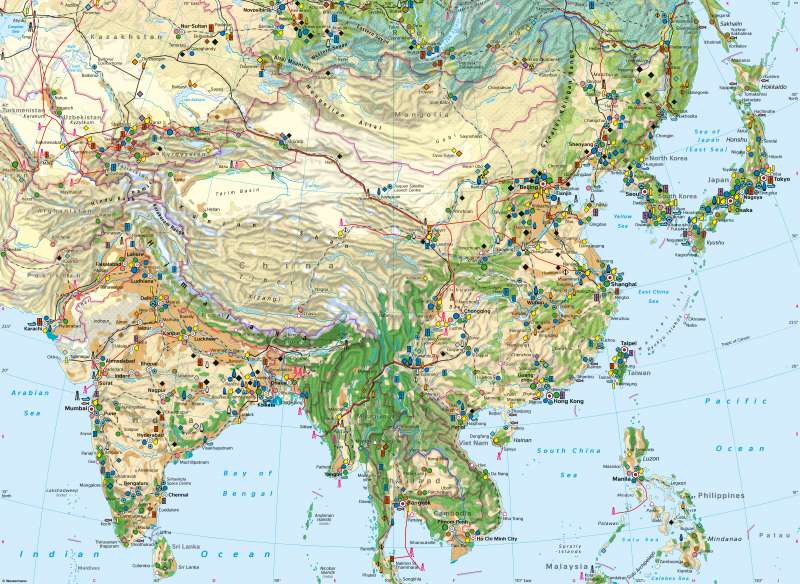South Asia and East Asia - Economy and land use
Economy and land use
978-3-14-100890-6 | Page 128 | Ill. 1

Overview
Together with Europe and the US, East Asia is one of the three hubs of the globalised economy. A diverse and strongly export-oriented industry, which has often developed despite unfavourable spatial conditions and a lack of raw materials, and a strong service sector characterise the economy. Most locations are found along the densely populated coasts. The ports there are connected to all parts of the world, and they are also used to import a large number of raw materials and industrial goods needed. Among the most important agricultural landscapes on earth are the North China Plains and the Red Basin.
Economies of East Asian countries
The distribution of industries shows that Japan, the world's third largest economy, has the highest industrial density in East Asia. In the areas of steel production, shipbuilding, and motor vehicle construction, in the chemical and electrotechnical industry/electronics, Japan ranks among the leading industrialised countries in the world. In steel production, Japan ranks second in the world (after China) despite the lack of its own raw material base.
Industrial development in Taiwan began with labour-intensive light industry (leather, textiles, clothing), from 1960 onwards a more sophisticated export-oriented light industry was established, and from 1970 onwards a capital-intensive steel, machinery, and vehicle industry as well as electronic and chemical industry. Domestic energy sources and other mineral resources are hardly available. Nevertheless, the country has a modern and diversified economic structure today.
In South Korea, similar to Taiwan, a forced industrialisation path was followed with limited raw materials. From the beginning of the 1970s, South Korea saw a concentrated build-up of steel production, shipbuilding, the chemical industry, automotive and mechanical engineering. In the first half of the 1980s, the country turned more towards capital-, technology- and knowledge-intensive industries and services. Not only the electrical industry, car manufacturing and mechanical engineering were promoted, but also electronics and biotechnology. At the same time, the state supported the large conglomerates, the chaebol, with financial aid and tax breaks.
South Korea and Taiwan are going through industrial development cycles, following in Japan's footsteps. Both countries repeatedly took over industries that had peaked in Japan. In the 1960s and 1970s, Taiwan and South Korea focused on the textile industry, which was already stagnating in Japan, and on simple consumer electronics. Today, South Korean companies are competing with their Japanese rivals in cars, computers, mobile phones, and consumer electronics, and have even outstripped them in many areas.
South Korea is also very active in the growing industry of biotechnology and in the service sector. The country's business locations are strongly networked internationally.
The People's Republic of China occupies a special position with its path towards a socialist market economy. Due to its high economic growth, export orientation and huge domestic market, the country has risen to become one of the most important economic nations on earth. In terms of GDP, China currently ranks second in the world (after the USA). Since the beginning of economic reforms, the special economic zones on the coast and the "open coastal cities" established in 1984 have experienced the fastest economic growth; at the same time, they are the regions with the largest share of export-oriented enterprises.
Economies of South Asian countries
Mass poverty and high technology - India, the emerging and by far the most important economy in South Asia, stands for both. In India's neighbouring countries, only the big cities (Rangoon, Dhaka, Karachi, Lahore) are industrial locations. Nepal and Sri Lanka are important destinations for international tourism.
Today, India is one of the largest industrialised countries in the world and, like Pakistan, has developed branches of high technology, for example in the nuclear industry, in rocket construction or in the computer sector. India is also becoming increasingly important as a service location (e.g. software development). The spatial distribution pattern of industry shows a concentration in a few large cities and their surrounding areas (Mumbai, Delhi, Bangalore, Madras, among others). The industrial growth centre is the state of Maharashtra with Mumbai (Bombay) as its centre. As in Pakistan, the textile industry is traditionally of great importance.
A structural problem in India is the high state share in the economy. State intervention used to be the norm. Nothing was to be imported that could also be produced in India, and foreign influences were deliberately kept out. In the early 1990s, there were economic reforms. Since then, majority holdings by foreign capital have been possible, and the Indian market has been opened up. In 2012, the government introduced further liberalisation for foreign investment. However, the strong growth has not eliminated the regional disparities in development and the income gap between the urban middle class and the poor rural population, but they rather increased. Almost every third Indian lives on an income below the poverty line.




